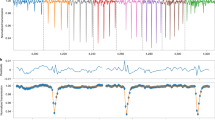Abstract
Recent measurements1,2 on ice samples from Camp Century (Greenland, 77°10'N, 61°08'W), Byrd Station (Antarctica, 80°01'S, 110°31'W) and Dome C (74°40'S, 125°10'E) suggest that during the late part of the last glaciation the atmospheric CO2 concentration was significantly lower than during the Holocene. Further investigation of this natural increase of the atmospheric CO2 concentration in the past should aid our understanding of the climatic implications of the man-made CO2 increase since the beginning of industrialization3. Here we report new and precise measurements of the CO2 concentration of the air occluded in bubbles of ice samples from Camp Century and Byrd Station, using a new dry extraction technique. The extracted gases were analysed with an IR-laser spectrometer (IRLS). Samples from 22 different depths were analysed from each core. The samples are distributed over a depth interval corresponding approximately to the past 40,000 yr. In addition results for ice samples from selected depth horizons from a colder region (North Central, Greenland 74°37'N, 39°36'W) and from a warmer region (Dye-3, Greenland 65°11'N, 43°50'W) are given. Based on these results we estimate the trend of the atmospheric CO2 concentration during the past 40,000 yr.
This is a preview of subscription content, access via your institution
Access options
Subscribe to this journal
Receive 51 print issues and online access
$199.00 per year
only $3.90 per issue
Buy this article
- Purchase on Springer Link
- Instant access to full article PDF
Prices may be subject to local taxes which are calculated during checkout
Similar content being viewed by others
References
Berner, W., Oeschger, H. & Stauffer, B. Radiocarbon 22, 227–235 (1980).
Delmas, R. J., Ascencio, J.-M. & Legrand, M. Nature 284, 155–157 (1980).
Keeling, C. D. & Bacastow, R. B. in Energy and Climate 72–75 (National Academy of Sciences, Washington DC, 1977).
Stauffer, B., Berner, W., Oeschger, H. & Schwander, J. Zeitschrift für Gletscherk. Glazial-geol. 16, (in the press).
Zumbrunn, R. thesis, Univ. Bern (1981).
Johnsen, S. J., Dansgaard, W., Clausen, H. B. & Langway, C. C. Jr Nature 235, 429–434 (1972).
Raynaud, D., Delmas, D. & Lourius, C. Actes du Colloque de Grenoble, 77–81. (IAHS-AISH Publ. no. 118, 1977).
Bolin, B. & Keeling, C. D. J. geophys. Res. 68, (1963).
Cragin, J. H., Herren, M. M., Langway, C. C. Jr & Klauda, G. SCOR/SCAR Polar Oceans Conf. (McGill University, Montreal, 1974).
Hammer, C. U. et al. J. Glaciol. 20, 3–26 (1978).
Siegenthaler, U., Heimann, M. & Oeschger, H. Radiocarbon 22, 177–191 (1980).
Broecker, W. S. CIMAS Symp. (ed. Kraus, E.) (University of Miami, 1980).
Conf. Carbon Dioxide and Climate: A Scientific Assessment (U.S. National Academy of Sciences, Washington DC 1979).
Schneider, S. H. J. Atmos. Sci. 32, 2060–2066 (1975).
CLIMAP Science 191, 1131–1137 (1976).
Author information
Authors and Affiliations
Rights and permissions
About this article
Cite this article
Neftel, A., Oeschger, H., Schwander, J. et al. Ice core sample measurements give atmospheric CO2 content during the past 40,000 yr. Nature 295, 220–223 (1982). https://doi.org/10.1038/295220a0
Received:
Accepted:
Issue Date:
DOI: https://doi.org/10.1038/295220a0
This article is cited by
-
The Isotopic Imprint of Life on an Evolving Planet
Space Science Reviews (2020)
-
An updated review about carbon dioxide and climate change
Environmental Earth Sciences (2018)
-
Global warming preceded by increasing carbon dioxide concentrations during the last deglaciation
Nature (2012)
Comments
By submitting a comment you agree to abide by our Terms and Community Guidelines. If you find something abusive or that does not comply with our terms or guidelines please flag it as inappropriate.



